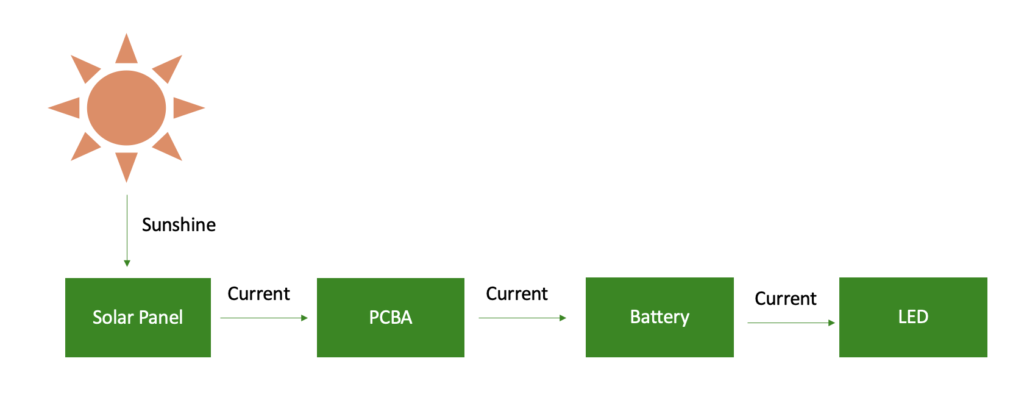How Does Solar Lights Work?
Home – Info Center – Blogs –
How Does Solar Lights Work?

By Michael Zhang || Updated on 3rd August 2024
Michael Zhang is a seasoned professional with 15 years of experience in the solar lights industry. Throughout his career, he has been actively involved in product design and developing, gaining valuable expertise and insight into the industry. Known for his dedication and professionalism, Michael has contributed significantly to the growth and success of various solar lights projects. His extensive knowledge and hands-on experience make him a trusted authority in the field, and he continues to innovate and excel in his role.
With the increasing use of solar lights in outdoor lighting, many new customers are curious about how solar lights actually work, that today will be through this article to fully understand the working process of solar energy.
Before we start to explain the working principle, let’s learn about the core components of solar lights.
Solar Panel: The solar panel is one of the core components of a solar light, this component is responsible for capturing the light energy from the sun and converting it into electricity. The solar panel consists of a number of photovoltaic cells, which are usually made up of silicon, and when the sunlight hits these cells, it excites the electrons in the silicon to produce direct current (DC) electricity.
Rechargeable Battery: The DC power generated by the solar panel needs to be stored in a “small container” so that it can be used at any time, and that small container is the “rechargeable battery”, the vast majority of rechargeable batteries used in solar lights on the market are: Ni-MH batteries, lithium batteries, LiFePO4, there are also a few very low-quality solar lights using Ni-Cd batteries, however, but with the development of technology, Ni-Cd batteries have been gradually eliminated by the market.
PCBA: PCBA is equivalent to the human brain, responsible for receiving and executing instructions, that in the body of the solar lamp, he is to control the input and output of the appropriate current and voltage, as well as balancing the time of the light, the time to turn off the light, adjusting the mode of the light and so on, PCBA is the natural signals and the requirements of human beings to transform the center of the brain.
LED: LED is the core of lighting, the current inside the rechargeable battery is the blood of LED lighting, with the support of the current, LED is the beginning of the luminous heat to serve mankind.

Remove the shell, the above four parts are the organs of the solar light, by cooperating with each other to realize different lighting needs, so how do they cooperate with each other?
Daytime operation: During the day, the solar panel absorbs sunlight and converts it into electrical energy. This energy is then stored in a rechargeable battery via a PCBA. the PCBA ensures that the battery is charged safely and efficiently, preventing any damage caused by overcharging.
Night operation: When the sun goes down and the ambient light diminishes, the light sensor on the PCBA detects the change in light level. It then sends a signal to turn on the LEDs, which are powered by electricity stored in the battery. the LEDs illuminate the area all night long, providing a reliable light source.
Continuous Cycle: This process repeats itself every day. During the day, the solar panel continues to capture sunlight and charge the battery, while at night, the stored energy powers the LED light. This continuous cycle allows the solar lights to operate independently of the power grid, reducing electricity costs and environmental impact.
What Is Solar Induction Light?
Solar Induction Light, compared with ordinary solar lights, is to add a sensor on the PCBA to realize the effect that the light comes on when people come and goes off when people leave, so as to make the solar lights more energy-saving and efficient.
When Do Solar Lights Come On?
This is adjusted according to the solar light manufacturer’s program, usually the supplier will set a LUX value interval, such as below 70LUX light on, above 120LUX light off. Customers can also discuss with their suppliers and set their own LUX value according to their actual needs.
Can Artificial Light Charge A Solar Panel?
Artificial Lights cannot charge a solar panel because the wavelength of Artificial Lights is not exactly the same as the sunlight, therefore the power generated is very low.
Can Grow Lights Charge Solar Panels?
Grow Lights also cannot charge solar lights, so the spectrum band of grow lights is specially customized according to certain plants and cannot achieve the full spectrum of sunlight, so the electricity generated is also very low.
Can I Take Solar Lights On A Plane?
Yes, many of our customers have taken samples of solar lights on airplanes, but remember that products with batteries cannot be checked in, they can only be carried-on.
Conclusion
FLIGREEN, as a manufacturer of solar lights with the highest quality standards in China, we are committed to the fundamentals to make more reliable and efficient solar light products, whether for gardens, pathways or public places, solar lights are a practical and environmentally friendly alternative to traditional lighting systems.
Related Blogs
September 20, 2024
August 12, 2024
Share Via:
Get in Touch with Us Now!
Got questions or feedback? We’d love to hear from you! Just fill out the form below, and our friendly team will respond ASAP.
